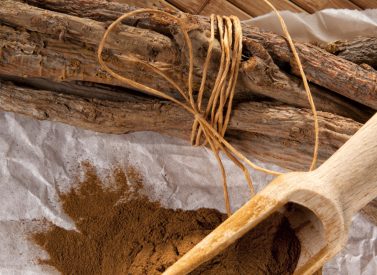Scientific Name: Glycyrrhiza glabra
Constituents:
- Triterpene saponins: glycyrrhizin (glycyrrhizic acid) & glycyrrhetinic acid
- Flavonoids & iso-flavonoids (Glabrene & liquiritin/isoliquiritigenin)
- Phytosterols
- Mucilage & Polysaccharides (glucans), lignans & starch
- Coumarins
- Volatile oils
- Amino acids
Medicinal actions:
- Adaptogen & Adrenal tonic
- Anti-inflammatory
- Antimicrobial (anti-viral)
- Antispasmodic
- Demulcent
- Expectorant
- Hepatoprotective
Mechanism of Action & Pharmacology:
- Triterpene saponins, glycyrrhizic acid & glycyrrhetinic acid are responsible for the majority of therapeutic effects.
- Glycyrrhizic acid (aka. glycyrrhizin or GL) is the glycoside of Glycyrrhetinic acid (GA), and is converted to GA by the flora of the large bowel, from where it is absorbed. Hence all the systemic effects of oral GL are in fact due to GA, as all orally administered GL is almost completely hydrolyzed by intestinal bacteria and reaches the systemic circulation as GA.
- Both GA & GL produce aldosterone-like effects upon the kidney and can lead to a syndrome known as apparent mineralocorticoid excess syndrome or pseudohyperaldosteronism, arising primarily from the inhibition of 11β-Hydroxysteroid dehydrogenase (11β-HSD) (family of enzymes that catalyze the conversion of inert cortisone into active cortisol), leading to a subsequent increase in the activity of cortisol.
- This is physiologically important because aldosterone and cortisol have similar affinity for mineralocorticoid receptors. (Note: GA is considered 200-1000 times more potent an inhibitor of 11β-HSD compared to GL). This mineralocorticoid-like activity occurs not only by blocking 11β-HSD, but also through direct binding to mineralocorticoid receptors, and in vitro studies on rat liver preparations have shown that both GA and GL inhibit 5β-reductase and likely also inhibit the breakdown of corticosteroids & aldosterone by the liver.
- This all leads to a high level of cortisol in the kidney, which in turn activates type 1 mineralocorticoid receptors to cause sodium retention (hypernatremia), hypokalemia, and potentially hypertension.
- Anti-inflammatory mechanism of Licorice is not fully understood. GAs similar structure to endogenous corticosteroids may be involved, however neither GA or GL have any intrinsic glucocorticoid action (although they can potentiate the action of hydrocortisone). GA does not appear to inhibit prostaglandin synthesis, although in vitro studies have shown that GL does inhibit prostaglandin production and phospholipase A2. It has been proposed that GA may inhibit the migration of white cells into sites of inflammation. Oral doses of GL were anti-inflammatory in adrenalectomized rats, and GA was found to have similar anti-inflammatory activity to hydrocortisone in experimental arthritis in normal rats. GL has also been shown to increase the anti-inflammatory action of cortisol, while antagonizing some of its less desirable effects, such as its suppressive effect on ACTH synthesis and secretion.
- GL (but not GA) inhibits virus growth and in some instances inactivates virus particles. (e.g. herpes simplex & HIV). Note: oral doses of GL will not have systemic anti-viral effects, but will be active as topical anti-viral especially for herpes simplex and shingles.
- GA antagonises some of the effects of exogenously administered estrogen, but does not appear to affect endogenous levels of estrogen.
- Isoflavonoids are anti-microbial and mildly estrogenic. Glabrene & glabridin have exhibited varying degrees of estrogen receptor agonism in different tissues in vitro and in vivo.
- Polysaccharides (glucans), Mucilage, GL & GA appear responsible for ulcer healing are demulcent.
- Isoliquiritigenin has strong antispasmodic activity and is an active inhibitor of monoamine oxidase.
Pharmacy:
- Decoction
- Tincture
- Capsule
- Pulse dose
Safety & Toxicity Concerns:
- Minimal adverse effects if intake is less than 10 g/day. Avoid long-term use at doses > 100 mg/day glycyrrhizin unless under close supervision. Place patients on a high potassium diet.
- Use with caution in hypertension, cardiovascular disorders, edema associated with heart failure, liver problems, kidney insufficiency, hypokalemia, hyperparathyroidism, male infertility or erectile dysfunction.
- Pseudohyeroaldosteronism may manifest as suppression of renin-angiotensin-aldosterone axis, cardiac arrest, arrhythmia, edema, hypokalemia, and hypertension.
- May cause stomach upset, edema, headache, and temporary visual disturbance.
- Clinical studies shown adverse effects appear greater in women, and indicate that renal function may also be a factor.
- May antagonize/agonize estrogen receptors, decrease testosterone, and increase parathyroid hormone.
- Avoid in pregnancy, lactation, and when on dialysis.
Interactions:
- May decrease effectiveness of most anti-hypertensive medications including ACE-inhibitors (may mask the development of pseudoaldosteronism), and estrogen-based oral contraceptive.
- May potentiate the action or increase levels of corticosteroids (e.g. cortisol (hydrocortisone & prednisone).
- Will reduce side effects of spironolactone (potassium sparing diuretic), while combining with thiazide and loop (potassium depleting) diuretic could result in excessive potassium loss.
- May decrease clearance or levels of immunosuppressives (e.g. sirolimus), Midazolam, Omeprazole.
- May result in excessive potassium loss when combined with potassium-depleting drugs (e.g. diuretics eg corticosteroids, stimulant laxatives), and potentiate the toxicity of cilostazol, digoxin. (increased likelihood of cardiac arrhythmias particularly in individuals with ischemic heart disease).








